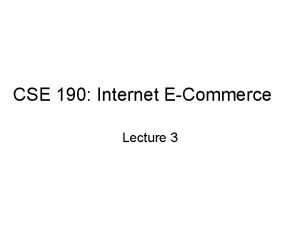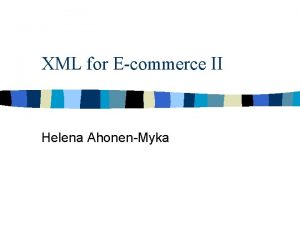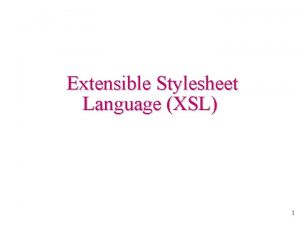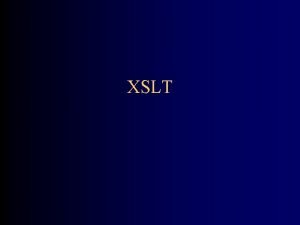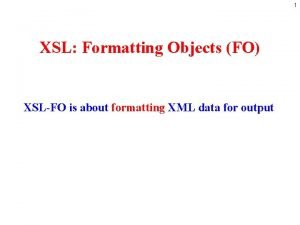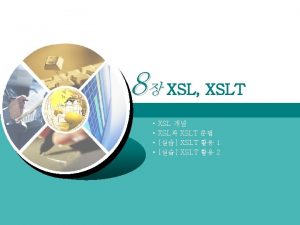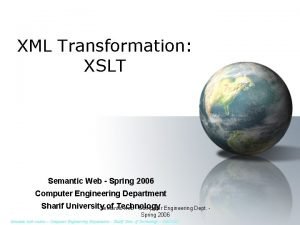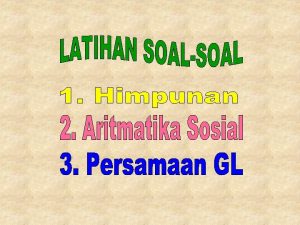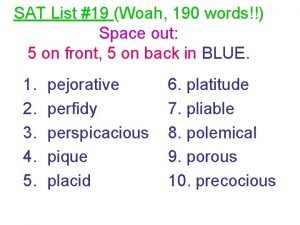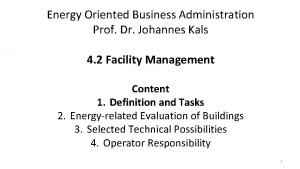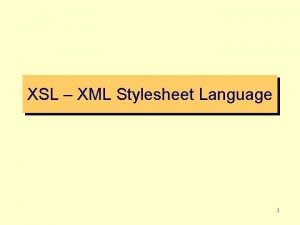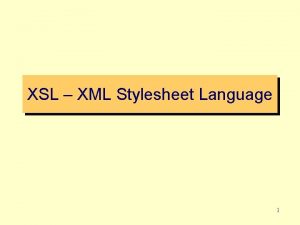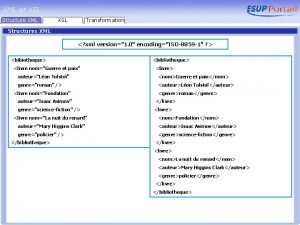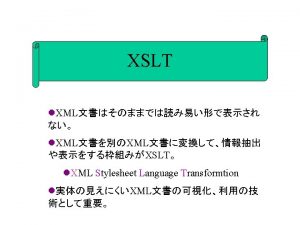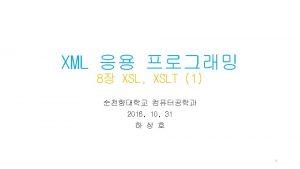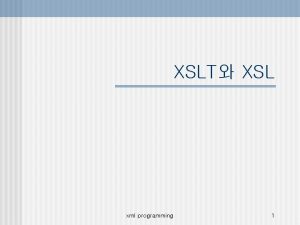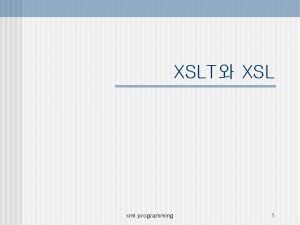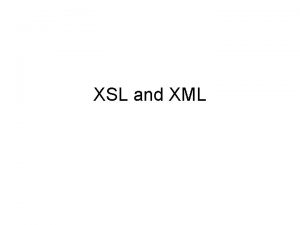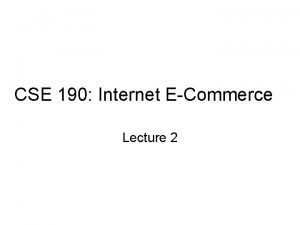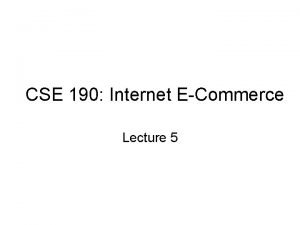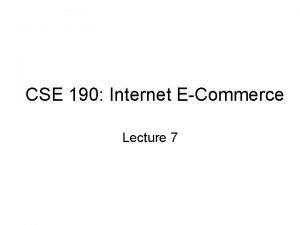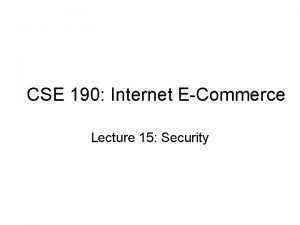CSE 190 Internet ECommerce Lecture 17 XML XSL



















- Slides: 19

CSE 190: Internet E-Commerce Lecture 17: XML, XSL

Problem: Communicating data • Consider: A merchant, like Amazon, wants to publish its catalog of books on sale to a third party (e. g. a book club), so that party can create a newsletter using the data. • Question: What format does Amazon put that data in? How do we communicate that format to the third party?

Some Approaches 1. Define binary format based upon some structure. Distribute a Word document describing the layout of the fields. struct Book { char isbn[ 40 ]; char author. First. Name[ 60 ]; char author. Last. Name[ 60 ]; float sale. Price; enum SHIPPING_AVAILABILITY { IN_STOCK, SOLD_OUT }; … }; Limitation: Adding a new field means the parsing code must change; takes weeks for programmers to read the specification and write the parser; future applications like this require equal amounts of work.

Some Approaches 2. Output the data in HTML, send a Word document describing the layout of the data. Ex: <html><head></head><body> <table> <thead><tr><th>Title</th><th>ISBN</th><th>Author</th ><th>Price</th></tr> <tr><td>Fast Food Nation</td><td>234234234</td><td>Eric Schlosser</td><td>17. 50</td></tr>… Evaluation: + At least we can use the HTML parser to get the data - Still have to parse the resulting HTML tree to get data - Adding new data fields still implies writing more parse code

Approach: Common syntax with user defined tags • Use a strict syntax for tags, but allow any tag name to be used: <booklist> <book isbn=“ 0395977894”> <title>Fast Food Nation</title> <author>Eric Schlosser</author> <Price>17. 50</Price> <book isbn=“ 1406066985”> …. Evaluation: + Directly expresses the data we wanted to communicate + May re-use the same parser for many different applications + Easy to ignore unfamiliar tags • Call it XML: Exchange Markup Language

What is XML? • XML: Used to communicate data to machines. • HTML: Used to communicate documents to people. • XML: An application of SGML (a document type description language) – Unlike HTML, you may invent your own tags – Uses a strict syntax so that XML parsers may be reused for many applications – Unknown tags and attributes are ignored – May be used to separate content from presentation by applying a transformation to the data to create a readable document. – Written in plain-text files; human-readable, not binary

XML Example • Show me the list of books on sale. <? xml version=“ 1. 0” ? > <booklist> <book isbn=“ 234234234”> <title>Fast Food Nation</title> <author>Eric Schlosser</author> <price>17. 50</price> <in_stock /> </book> <book isbn=“ 456465465”> <title>Religion Explained</title> <author>Pascal Boyer</author> <price>24. 99</price> <out_of_stock /> </booklist>

XML Example • Show me the grades of all students. <? xml version=“ 1. 0”> <studentgrades> <student id=“A 02111111”> <exam 1>15</exam 1> <exam 2>15</exam 2> <project>16</project> <final makeup=“yes”>14</final> </student> <student id=“A 02222222”> <exam 1>15</exam 1> <exam 2>15</exam 2> <project>16</project> <final makeup=‘no’>15</final> </studentgrades>

XML Syntax • • Written in plain text (using notepad, e. g. ) All elements must have a closing tag • Single element tags close themselves • Should start with an XML document indicator – Ex: <p>Text text</p> – Forbidden: <p>Line One<p>Line Two – Ex: – Not: text or text</br> – Ex: <? xml version=“ 1. 0”? > • • Has one root element, the first in the document All attribute values must be single or double quoted • Tags are case sensitive – Ex: <boat_ride price=“ 15. 00” /> – Not: <boat_ride price=15. 00 /> – Not: <image_size width=100% /> – Ex: <author>Eric Schlosser</author> – Not: <author>Eric Schlosser</Author> • Mime Type: text/xml

Parsing • An XML parser may parse any XML document • Well-formed: XML document follows the XML syntax rules • Valid: XML document conforms to its specified DTD (Document Type Definition) <? xml version="1. 0“ ? > <!DOCTYPE note SYSTEM "note. dtd"> <note> <to>Manny</to> <from>Janni</from> <heading>Reminder</heading> <body>Don't forget me this weekend!</body> </note>

DTDs • DTDs: Describe the allowable tags and attributes used in an XML document <!DOCTYPE TVSCHEDULE [<!ELEMENT TVSCHEDULE (CHANNEL+)> <!ELEMENT CHANNEL (BANNER, DAY+)> <!ELEMENT BANNER (#PCDATA)> <!ELEMENT DAY (DATE, (HOLIDAY|PROGRAMSLOT+))+> <!ELEMENT HOLIDAY (#PCDATA)> <!ELEMENT DATE (#PCDATA)> <!ELEMENT PROGRAMSLOT (TIME, TITLE, DESCRIPTION? )> <!ELEMENT TIME (#PCDATA)> <!ELEMENT TITLE (#PCDATA)> <!ELEMENT DESCRIPTION (#PCDATA)> <!ATTLIST TVSCHEDULE NAME CDATA #REQUIRED> <!ATTLIST CHANNEL CHAN CDATA #REQUIRED> <!ATTLIST PROGRAMSLOT VTR CDATA #IMPLIED> <!ATTLIST TITLE RATING CDATA #IMPLIED> <!ATTLIST TITLE LANGUAGE CDATA #IMPLIED> ]> • Written in SGML

Namespaces • • • Question: How do we create a document using tags from two different DTDs? We can just combine the two, using the tags from both DTDs Problem: What if both DTDs are using the same tag name to refer to different items? Solution: We can specify what namespace a tag is coming from. Namespaces: Specify the DTD that a tag name is relative to Example: <? xml version=“ 1. 0”? > <amzn: booklist xmlns: amzn=“http: //www. amazon. com/deals/BL”> <amzn: book isbn=“ 23423422”> <amzn: author>Eric Schlosser</amzn: author> <loc: category xmlns: loc=“http: //www. libraryofcongress. org/classify”> Food, muckraking</loc: category> <amzn: price>17. 50</amzn: price> </amzn: booklist>

Viewing XML • XML documents may be viewed natively in IE, Netscape – Ex: testdoc. xml • What if we’d like to present the data to people, in a more readable way? – Useful for: creating data documents, then a clearly separated way for viewing the data – XML Transformation into a view • CSS • XSLT

CSS • CSS: Cascading Style Sheets • Applied to XML, similar to HTML • Example (note the tags in the selector): CATALOG { background-color: #ffffff; width: 100%; } CD { display: block; margin-bottom: 30 pt; margin-left: 0; } TITLE { color: #FF 0000; font-size: 20 pt; } ARTIST { color: #0000 FF; font-size: 20 pt; } COUNTRY, PRICE, YEAR, COMPANY { display: block; color: #000000; margin-left: 20 pt; } • Limitation: Not all browser versions support XML + CSS display

XSL • XSL: XML Style Language • Provides declarative method for transform XML document into a viewable format (usually HTML)

XSL Example <? xml version="1. 0“ ? > <xsl: stylesheet version="1. 0“ xmlns: xsl="http: //www. w 3. org/1999/XSL/Transform"> <xsl: template match="/"> <html> <body> <table border="1"> <tr> <th>Title</th> <th>Artist</th> </tr> <xsl: for-each select="catalog/cd"> <tr> <td><xsl: value-of select="title" /></td> <td><xsl: value-of select="artist" /></td> </tr> </xsl: for-each> </table> </body> </html> </xsl: template> </xsl: stylesheet>

XSL Elements • xsl: template – Replaces all elements matching the Xpath expression (e. g. “/” matches all elements) with the specified content • xsl: for-each – For each element matching the select Xpath expression, the element is replaced with the specified content • xsl: value-of – Is replaced with the text value of the element specified by select’s Xpath expression • Xpath: A pattern language for XML – / -> matches all elements – a/b -> matches all A elements with children of tag B

XSL, Server-Side • XML file may be made human-friendly by specifying style sheet from within the XML document – Uses client-side support to transform into HTML • What if the browser doesn’t support this? – The web server may do the transformation on the server side, giving the browser the resulting HTML. • May decide to detect the browser version before deciding on what method to use

References • Book: Step by Step XML by Michael Young • URL: http: //www. w 3 schools. com/xml/ • URL: http: //www. w 3 schools. com/xsl/
